Also the last pair of taro variants were special. They were not given
the expected numbers 11 and 12:
|
Variants of taro brought by Oti from
the plantations of Teke: |
|
1 |
*69 |
ngeti uri. |
a Teke. a Oti. |
|
2 |
*70 |
ngeti tea. |
|
3 |
*71 |
he ngaatu. |
|
4 |
*72 |
he tuitui koviro. |
|
5 |
*73 |
he ketu anga mea. |
|
6 |
*74 |
he ketu takarua. |
|
7 |
HAEDUS II |
he teatea. |
|
8 |
*76 |
he ngu haha tea. |
|
9 |
*77 = *66 + *11 |
he mango. |
|
10 |
RiGEL (*78) |
he hahara rapanui |
|
1 |
*79 |
he ti. |
|
1 |
*80 |
he kape. |
...
Teke said to Oti, 'Send the men [ka unga te tangata]
for banana shoots. They shall take all kinds of banana
shoots [anakeanake.te huru o te maika] from my banana
plantation, also taro, all kinds of taro, furthermore ti (Cordyline
fruticosa) and kape (Alocasia macrorrhiza ).'
[E:67]

Ti and kape were mentioned separately - presumably opposites and
complementary to each other. Whereas the ti roots were brought
onboard the Royal Double Canoe kape was not:
... (There were) five hundred baskets of banana shoots, a
thousand baskets of taro, fifty bundles of long ti roots, and
ten baskets of little kape seedlings [500 + 1000 + 50 + 10 = 26
* 60]. They tied up the baskets carefully, and Oti said to his
assistants, 'Take all the baskets [ka mau tahi te taropa]
on board the canoe [ki runga ki te miro], as well as [tokoa]
the hundreds of [?] ti roots!' The men picked up the baskets and
brought them on board the canoe. They arrived and left them
there [he tuu he hakarere]. [E:68-69]
|
7 he teatea. |
8 he ngu haha tea. |
9 he mango. |
10 he hahara rapanui
|
1 he ti. |
|
... When this
tremendous task had been accomplished Atea
took a third husband, Fa'a-hotu, Make
Fruitful. Then occurred a curious event. Whether
Atea had wearied of bringing forth offspring we
are not told, but certain it is that Atea and
her husband Fa'a-hotu exchanged sexes. Then
the eyes of Atea glanced down at those of his
wife Hotu and they begat Ru. It was
this Ru who explored the whole earth and
divided it into north, south, east, and west
...
Haha. 1. Mouth (oral cavity,
as opposed to gutu, lips). 2. To carry
piggy-back. He haha te poki i toona matu'a,
the child took his father on his back. Ka haha
mai, get onto my back (so I may carry you).
Vanaga. 1. To grope, to feel one's way; po haha,
darkness, obscure. 2. Mouth, chops, door, entrance,
window; haha pipi, small mouth; haha
pipiro, foul breath; ohio haha, bit of
bridle; tiaki haha, porter, doorkeeper.
Churchill. Hahaga. Ridge, summit, wall plate.
Maroa hahaga, to measure lands, to walk at a
great pace. Churchill.
Hara. Harahara 1. Misaligned
(of roofing, basketware, etc.); e harahara nó te
kete, the basket is misaligned (its strips are
not parallel. 2. A sort of taro. 3. Latrine,
defecating ground. Vanaga. 1. Pandanus. P Mgv.:
ara, puhara, pandanus (tree); hara,
a bunch of pandanus fruit, old pandanus. Mq.: faá
haá, pandanus. Ta.: fara, id. 2. Error,
mistake, oversight, wrong; to err, to confound, to
mistake; manau hara, illusion; toua hara,
discussion without knowing the object. P Mgv.:
ara, arara, defective, abortive, to miss,
to fail, a fault, a quarrel; hara, a fault, a
mistake, an error, a dispute, a quarrel,
undisciplined. Mq.: hara, a rake, libertine.
Ta.: hara, sin, fault, crime. Churchill.
Hanau. 1. Race, ethnic group.
Hanau eepe, the thick-set race; hanau
momoko, the slender race (these terms were
mistranslated as 'long-ears' and 'short-ears'). 2.
To be born. Hanau tama, pregnant woman;
vî'e hanau poki, midwive (also: vî'e hakaa'u).
Vanaga. To be born; vie hanau, midwife. P
Pau.: fanauga, child, descendant, progeny.
Mgv.: hanau, to be born, to be brought into
the world. Mq.: fanau, hanau, to be
born, to lie in, to bring into the world. Ta.:
fanau, to be born, to lie in. Churchill.
Ti by lying with Tattooing made the ti
plant (he ti ki ai ki roto ki a he ta ka pu te ti).
Burnt ti leaves were used to produce the
black dye for tattooing.
 |
|
APRIL 1 (59 + 32) |
2 |
3 (*13) |
4 |
5 (95 = 79 + 16) |
 |
 |
 |
 |
 |
|
Ga1-11 |
Ga1-12 |
Ga1-13 |
Ga1-14 |
Ga1-15 |
|
HAEDUS II
= η Aurigae
(75.9) |
5h (76.1)
ε
Leporis (76.0),
CURSA
(Footstool)
=
β
Eridani
(76.4),
λ
Eridani (76.7)
*35.0 = *76.4 - *41.4 |
μ
Aurigae, μ Leporis (77.6) |
ĸ Leporis (78.0),
RIGEL
(Foot)
=
β
Orionis
(78.1),
Flaming Star = IC405
(78.2),
CAPELLA
=
α
Aurigae
(78.4),
ο
Columbae,
τ
Orionis (78.8)
*37.0
= *78.4 - *41.4
THUBAN (α
Draconis)
|
λ Aurigae (79.0), λ Leporis (79.6), ρ Aurigae (79.7)
ARCTURUS (α
Bootis) |

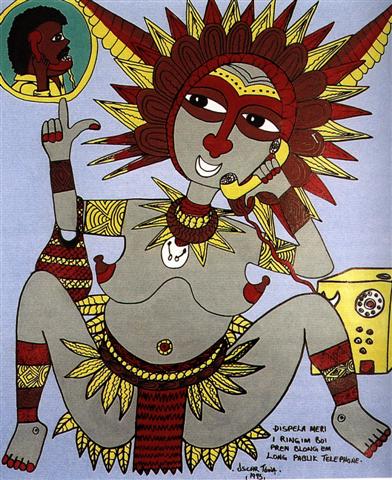
|
 |
 |
|
hanau |
RIGEL & CAPELLA
|
Hanau. 1. Race, ethnic group.
Hanau eepe, the thick-set race; hanau
momoko, the slender race (these terms were
mistranslated as 'long-ears' and 'short-ears'). 2.
To be born. Hanau tama, pregnant woman;
vî'e hanau poki, midwive (also: vî'e hakaa'u).
Vanaga. To be born; vie hanau, midwife. P
Pau.: fanauga, child, descendant, progeny.
Mgv.: hanau, to be born, to be brought into
the world. Mq.: fanau, hanau, to be
born, to lie in, to bring into the world. Ta.:
fanau, to be born, to lie in. Churchill.
|
17 |
|
he maika. a Teke. a
Oti. [E:67] |
he taro.
a Teke. a Oti. [E:68] |
|
no glyph |
3 |
 |
9 |
 |
2 |
|
HYADUM II
(*64) |
ALDEBARAN (*68) |
RIGEL (*78) |
|
Heart-5 (Fox)
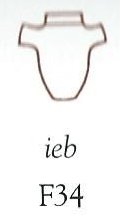 |
"April 17 (107) |
"April 27 (117) |
|
1 |
ANTARES (*249) |
SABIK (*259) |
|
 |
 |
|
13 |
|
|
June 4 |
5 |
6 (157 = 314 / 2) |
7 (94 + 64) |
8 (*444) |
|
°May 31 (151) |
°June 1 |
2 (*73) |
3 (94
+ 60) |
4 (*440) |
|
'May 8 (128) |
9 |
10 (*50) |
11
(94 + 37) |
12 (*52) |
|
"April 24 (114) |
Vaitu Nui 25 (*35) |
26 (4 * 29) |
27 (94 + 23) |
28 (118 = 4 * 29) |
|
... The Explorers had left their
old homeland in "April 25 (115) - implying the
synodic cycle of Mercury - and they
had returned half a year later,
in "October 25 (298 = 115 + 183), which was 10 days
after the arrival of the Royal Double Canoe ...
... Ganz
ähnlich is der Name 'Gott von Duazag' des
Gottes Nabū ... zu erklären.
Er bezeichnet ihn als den Gott
des Wachtstums, welches als aus dem Osten stammend
betrachtet wird, weil die Sonne, die das Wachstum
bringt, im Osten aufgeht. Dass aber Nabū
als Ost-Gott aufgefasst wurde, hängt damit zusammen,
dass sein Stern, der Mercur, nur im Osten oder
Westen sichtbar ist ...

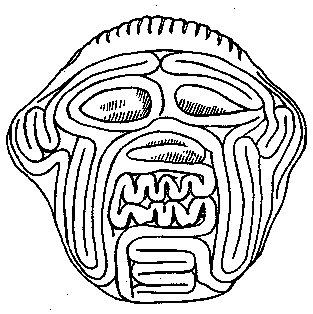 
 |
|
CLOSE TO THE FULL
MOON: |
|
OCT 1
(91 + 183) |
2
(275) |
3 |
4 |
5 |
|
17h
(258.7)
ARRAKIS = μ Draconis
(258.7) |
Mula-19 (The Root)
SABIK (The Preceding One)
=
η
Ophiuchi
(259.7),
η
Scorpii (259.9) |
NODUS I =
ζ
Draconis
(260.0),
π
Herculis (260.7),
RAS ALGETHI (Head of the Giant)
=
α
Herculis
(260.8) |
SARIN =
δ
Herculis
(261.0),
ο
Ophiuchi (261.4)
*220.0 = *261.4 - *41.4
ALRISHA (α
Piscium) |
ξ Ophiuchi (262.2), θ Ophiuchi, ν Serpentis, ζ, ι
Apodis (262.4), ι Arae (262.8), ρ Herculis (262.9)
*221.0 = *262.4 - *41.4 |
|
Dec 4 |
5 |
6 (*260) |
7 |
8 (342) |
|
°Nov
30 |
°Dec 1
(335) |
*(8 *
32) |
3 |
4
|
|
'Nov 7 |
8
(*232) |
9 |
10
(314) |
11 |
|
"Oct
24 |
Tangaroa Uri 25 |
26 |
27
(300) |
28 |
|
...
Page E:86 tells about Makoi being left behind
on Easter Island when the remaining 5 Explorers
sailed home to Hiva. From there (Tangaroa
Uri 25) to the day when Hotu became
worried about where Oto Uta was, i.e. in
Tangaroa Uri 30, there were 5 days:
|
April 25 (115) |
5 + 56 |
June 25 (176) |
5 + 116 |
Oct 25 (298) |
5 + 56 |
Dec 25 (359) |
5 + 116 |
|
61 |
2 * 61 |
61 |
2 * 61 |
|
183 |
183 |
|
366 = 2 * 183 = 6 * 61 |
And
from the autumn equinox (265) at Antares to the
Sting of the Scorpion (υ
Scorpii) there were 15 days
...

... the tubers [of kape]
had to be kept in the earth-oven for 15 (sic)
days in order to eliminate some of the poisonous
components ... 2 *
175 (Day of St John) = 350 = 365 - 15.
... Thus the regular
old Roman year ended with Februarius 23 and it was
350 nights long, 25 fortnights ... |
Kape. 'Bitter-taro' (Alocasia macrorrhiza). In
1957 kape was still cultivated in much the same way as
dry taro. It is a type of food to be eaten during times of
famine. According to Fuentes (1960:856), the tubers had to be
kept in the earth-oven for 15 (sic) days in order to
eliminate some of the poisonous components. Barthel 2. Arum,
yam. Churchill. Bitterness by doing it with Bad-taste produced
the kape (mangeongeo ki ai ki roto he rakerake ka pu
te kape).
The exceptional glyph Ga1-16 was singled out with a dot in front, and
another special pair followed:
|
1 he ti. |
1
he kape. |
|
1 he hauhau. |
1 he mahute. |
|
*79 |
*80 |
*81 |
*82 |
|
1
he kape. |
1 he hauhau. |
|
APRIL 6 (96) |
7 (*17) |
 |
 |
|
Ga1-16 |
Ga1-17 |
|
Shur-narkabti-sha-iltanu-5 (Star in the Bull towards
the north)
σ
Aurigae (80.4),
BELLATRIX (Female Warrior)
=
γ
Orionis,
SAIF AL JABBAR (Sword of the Giant)
=
η
Orionis
(80.7),
ELNATH (The Butting One)
=
β
Tauri = γ Aurigae
(80.9)
*39.0 = *80.4 - *41.4 |
ψ
Orionis (81.1),
NIHAL (Thirst-slaking Camels)
=
β
Leporis
(81.7) |
 |
|
June 9 (365 + 160
= 525) |
10 (161) |
|
... The month,
which takes its name from Juppiter the oak-god,
begins on June 10th and ends of July 7th. Midway
comes St. John's Day, June 24th, the day on which
the oak-king was sacrificially burned alive. The
Celtic year was divided into two halves with the
second half beginning in July, apparently after a
seven-day wake, or funeral feast, in the oak-king's
honour ...
 |
|
°June 5 (156) |
6 (*77) |
|
'May 13 (133) |
14 (*54) |
|
"April 29 (119) |
Vaitu
Nui 30 |
|
CLOSE TO THE FULL
MOON: |
|
OCT 6 (279 = 9 *
31) |
7 (*200) |
|
β, γ Arae (263.3), κ Arae (263.5), σ Ophiuchi
(263.6) |
LESATH (Sting) = υ Scorpii,
δ
Arae (264.7),
CHOO
(Club) = α Arae
(264.9) |
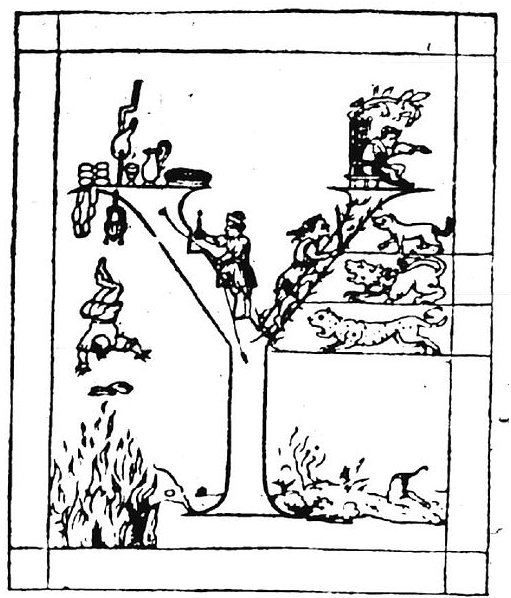
... For they say
that the course of human life resembles the letter
Y, because every one of men, when he has reached the
threshold of early youth, and has arrived at the
place 'where the way divides itself into two parts',
is in doubt, and hesitates, and does not know to
which side he should rather turn himself´...


 |

|
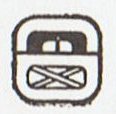 |
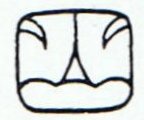 |
 |
|
uo ('imprisoned') |
akbal (night) |
quincunx (yellow) |
... we see the Xul-animal,
all his facial marks appearing, hanging by his tail
from the sky-band. With tail and both paws he holds
flaming torches. Above in the text [Dresden Codex,
55.g.] we can see our form 19.3.1;

... the
superfix is a club [cfr Choo, α Arae],
constantly appearing as an instrument of attack; it
is neither spear nor knife, and also shows the same
marks as are seen on wooden posts, for the knots;
the prefix we shall later see defined as the
conventionalized flames of firewood ... These three
elements united, the cauac, or Storm,
relámpago, rayo or lightning bolt as
rendered in the above cited vocabularies, with the
club or stick as superfix, and the flames as prefix,
give a complete compound for 'thunderbolt' ... |
|
Dec 9 (343 = 7 *
49 = 279 + 8 * 8) |
10 (161 + 183) |
|
°Dec 5 (339) |
6 (*260) |
|
'Nov 12 (*236 = 8
* 29½) |
13 (317 = 161 +
12 * 13) |
|
"Oct 29 (*222) |
Tangaroa Uri 30 |
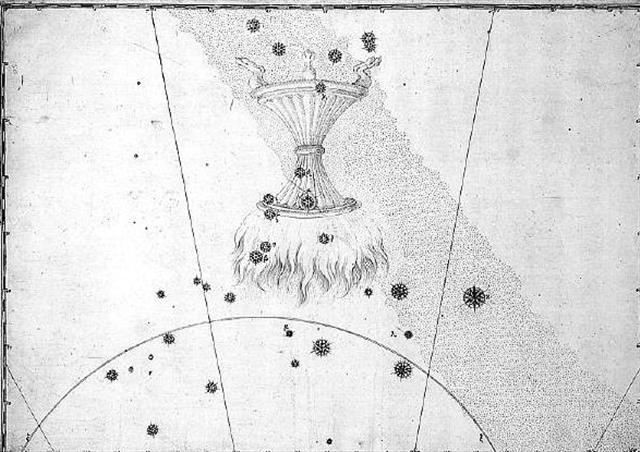 |
... It is known that in the final battle of the gods, the
massed legions on the side of 'order' are the dead warriors,
the 'Einherier' who once fell in combat on earth and who
have been transferred by the Valkyries to reside with Odin
in Valhalla - a theme much rehearsed in heroic poetry. On
the last day, they issue forth to battle in martial array.
Says Grimnismal (23): 'Five hundred gates and forty more -
are in the mighty building of Walhalla - eight hundred
'Einherier' come out of each one gate - on the time they go
out on defence against the Wolf.' That makes 432,000 in all,
a number of significance from of old. This number must have
had a very ancient meaning, for it is also the number of
syllables in the Rigveda. But it goes back to the basic
figure 10,800, the number of stanzas in the Rigveda (40
syllables to a stanza) [40 * 270 = 10800] which, together
with 108, occurs insistently in Indian tradition, 10,800 is
also the number which has been given by Heraclitus for the
duration of the Aiōn, according to Censorinus (De die
natali, 18), whereas Berossos made the Babylonian Great Year
to last 432,000 years. Again, 10,800 is the number of bricks
of the Indian fire-altar (Agnicayana). 'To quibble away such
a coincidence', remarks Schröder, 'or to ascribe it to
chance, is in my opinion to drive skepticism beyond its
limits.' ...
... In the islands of Bali and Lombok,
when the time of harvest has come, the owner of the field
himself makes a beginning by cutting 'the principal rice'
with his own hands and binding it into two sheaves, each
composed of one hundred and eight
stalks with their leaves attatched to them. One of the
sheaves represents a man and the other a woman, and they are
called 'husband and wife'. The male sheaf is wound about
with thread so that none of the leaves are visible, whereas
the female sheaf has its leaves bent over and tied so as to
resemble the roll of a woman's hair. Sometimes, for further
distinction, a necklace of rice-straw is tied round the
female sheaf. When the rice is brought home from the field,
the two sheaves representing the husband and wife are
carried by a woman on her head, and are the last of all to
be deposited in the barn. There they are laid to rest on a
small erection or on a cushion of rice-straw. The whole
arrangement, we are informed, has for its object to induce
the rice to increase and multiply in the granary, so that
the owner may get more out of it than he puts in. Hence when
the people of Bali bring the two sheaves, the husband and
wife, into the barn, they say, 'Increase ye and multiply
without ceasing' ...
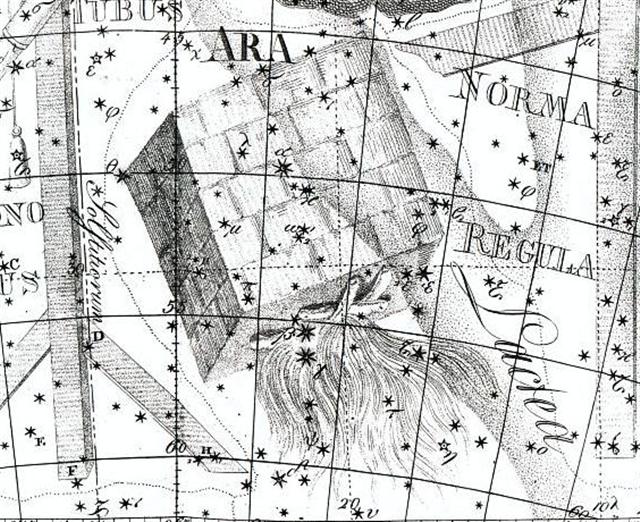
|


























